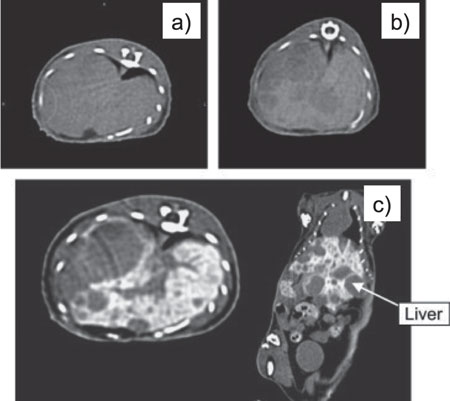| Posted: Apr 10, 2013 | |
Nanotechnology contrast agents for computed tomography (CT) |
|
| (Nanowerk Spotlight) Computed tomography (CT) scans are an imaging method that use x-rays to create pictures of cross-sections of the body. Many CT scans involve intravenously injected iodinated contrast agents – also called radiocontrast agents – in order to increase the sensitivity of the scan. One problem with conventional iodinated contrast agents is their rapid renal clearance and the resulting variation in contrast levels over the course of an examination or study. In addition, the X-ray attenuation of iodine is not efficient for clinical CT that uses high-energy X-ray. Sometimes, there are also serious adverse effects related to the excretion pathway induced by the rapid renal clearance. | |
| Due to these limitations, nano-sized iodinated CT contrast agents have been developed that can increase the circulation time and decrease the adverse effects. In addition to iodine, nanoparticles based on heavy atoms such as gold, lanthanides, and tantalum are used as more efficient CT contrast agents. | |
| In a new review article in the April 4, 2013 online edition of Advanced Materials ("Nano-Sized CT Contrast Agents") scientists from Seoul National University summarize the recent progresses made in nano-sized CT contrast agents. | |
 |
|
| CT images of cancerous liver of a mouse before injection (a), 3 minutes (b) and 4 hours (c) after intravenous injection of p(MAOETIB-GMA) nanoparticles. | |
| Iodine-based contrast agents | |
| Iodinated contrast agents are excreted rapidly through the kidney after administration, allowing only short imaging times. In addition, these agents are distributed nonspecifically throughout the intravascular and extravascular spaces, resulting in unclear CT images. To address these limitations, iodine-based contrast agents in the nanometer range, such as micellar, polymeric, iodinated metal-organic frameworks (MOFs), and liposomal contrast agents, have been developed. | |
| Gold nanomaterials | |
| Gold nanoparticles have been intensively studied for biomedical applications owing to their unique properties and high biocompatibility. Gold is an extremely inert material, and properly stabilized gold nanoparticles are biocompatible. Such high biocompatibility is great advantage for CT imaging where high dosages of contrast agent are required. | |
| In addition to spherical gold nanoparticles, gold nanorods can be used as CT contrast agents. Nanorods are known to be better able to evade clearance by phagocytes than spherical nanoparticles, exhibiting longer circulation time. | |
| Although the CT contrast effect is not affected by the shape of nanoparticles, gold nanorods are advantageous to develop multifunctional contrast agents owing to their strong extinction in the near infrared (NIR) region. In order to develop multimodal imaging agents, the differences in sensitivity of each imaging modality need to be considered. | |
| Lanthanide nanoparticle-based contrast agents | |
| Materials based on lanthanides with high atomic numbers can also be used as CT contrast agents. Among the lanthanides, gadolinium has been most intensively studied for biomedical applications because it is also used as a T1 MRI contrast agent due to its paramagnetic property. Since free lanthanide ions are very toxic, chelating agents are employed to reduce the toxicity. | |
| In addition to lanthanide chelates, nano-sized CT contrast agents can be prepared by encapsulating lanthanide ions within emulsion or synthesis of lanthanide-doped inorganic nanomaterials. | |
| Recently, multifunctional upconverting fluorescent nanoparticles that consist of lanthanide ions in a matrix have been intensively studied. Unlike common fluorophores such as fluorescent dyes and quantum dots, upconverting fluorescent nanoparticles emit high-energy photons in the visible or NIR range upon irradiation with longer wavelengths of NIR light. | |
| Other heavy metal-based contrast agents | |
| Both, tantalum and bismuth nanoparticle-based contrast agents have enormous potential as a CT contrast agent because of their high biocompatibility and good radiopacity and, in the case of bismuth, also cost-effectiveness. | |
| Because tantalum oxide can be easily modified with various silane agents, it is straightforward to develop multimodal probes using tantalum oxide nanoparticles. Furthermore, tantalum oxide is highly transparent to NIR and visible light. | |
| Bismuth has been used as an ingredient in pharmaceuticals and cosmetics. Since metallic bismuth is too reactive to be used in vivo, Bi2S3 nanoparticles coated with polyvinylpyrrollidone (PVP) are used as CT contrast agents. | |
| The authors note that, although nanoparticulate CT contrast agents have had less attention than alternate imaging modalities such as MRI and fluorescence imaging, recent interest in CT contrast agents has grown rapidly. | |
| They conclude their review by pointing out the benefits of nanosized CT agents: | |
|
|
|
| Although currently available iodinated contrast agents are not suitable for multicolor CT due to their relatively low K-edge energies, new CT contrast agents based on biocompatible heavy atoms such as gold, tantalum, bismuth, and lanthanides can overcome this limitation, permitting identification of different materials with single imaging. | |
 By
Michael
Berger
– Michael is author of three books by the Royal Society of Chemistry:
Nano-Society: Pushing the Boundaries of Technology,
Nanotechnology: The Future is Tiny, and
Nanoengineering: The Skills and Tools Making Technology Invisible
Copyright ©
Nanowerk LLC
By
Michael
Berger
– Michael is author of three books by the Royal Society of Chemistry:
Nano-Society: Pushing the Boundaries of Technology,
Nanotechnology: The Future is Tiny, and
Nanoengineering: The Skills and Tools Making Technology Invisible
Copyright ©
Nanowerk LLC
|
|
|
Become a Spotlight guest author! Join our large and growing group of guest contributors. Have you just published a scientific paper or have other exciting developments to share with the nanotechnology community? Here is how to publish on nanowerk.com. |
|
